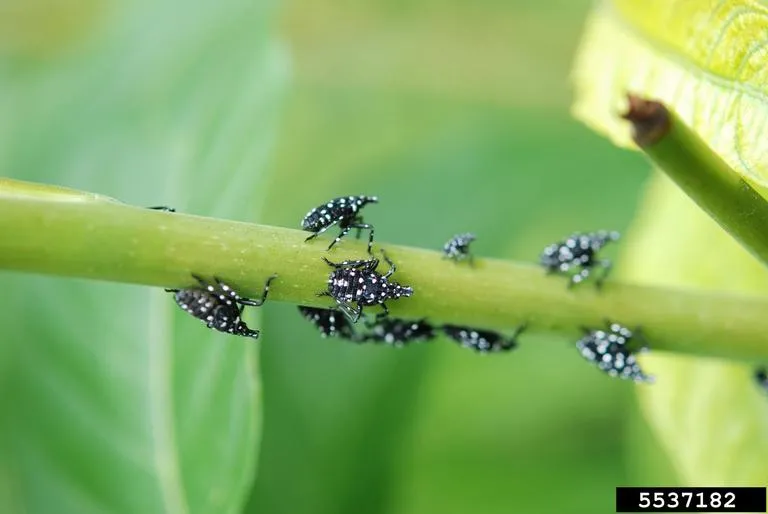Above photo by Dalton Ludwick on Penn State Extension website. An early-stage nymph (1st-3rd instars). According to Penn State Extension, these hatch from the eggs and are just a few millimeters in length. As they age, they grow to be ~1/4 inch long. They have black bodies and legs and are covered in bright white spots. They are strong jumpers and will jump when prodded or frightened.
We have not had any confirmed cases of spotted lanternfly (SLF) as of early July in Whitley County, but they have been confirmed in nearby Huntington County to our south. I urge local residents to be on the lookout for this new economically damaging pest of orchards and vineyards.
There are two known populations of SLF in Indiana. The first population was found in 2021 in Switzerland County, and the second population was found in Huntington County in 2022.
Dr. Alicia Kelley, Indiana Cooperative Agricultural Pest Survey (CAPS) State Survey Coordinator at Purdue University, recently wrote about egg hatch and early instars (nymphs) of spotted lanternfly in Huntington County.
“Egg hatch was confirmed in Huntington County and Switzerland County in mid-May at the two known sites,” she said. “A few adults have been caught about one mile south of the core infestation site in Huntington; however, there are not any new infestations reported as of July 2023.” She added that Indiana Department of Natural Resources (IDNR) employees have completed several egg scraping events at the infestation sites, removing over 16,800 egg masses so far this year. That’s over 672,000 eggs!
“Finding this invasive insect early is crucial to preventing its spread as long as possible,” she said. “Currently, SLF nymphs are in their 1st-3rd instar, so watch for small, black, white-spotted bugs on Tree-of-Heaven.” She described later instars as black and red with white spots. The adults are about 1 inch long, with very brightly colored wings. The forewings are light brown with black spots, and the underwings are a striking red and black, with white band in between the red and black. When at rest, the adult SLFs appear light pinkish-grey.

Several early-stage SLF nymphs feeding on tree-of-heaven. According to Penn State Extension, early instars tend to feed on new growth of a plant, such as the stems and foliage. Image by Pennsylvania Department of Agriculture.
The preferred host is the invasive Tree-of-Heaven, but it also feeds on a wide range of important plant species, including grapes, walnuts, maples, and willows.
Cliff Sadof, Purdue entomologist, said in a separate article for the Purdue Landscape Report, “This federally regulated invasive species is a serious new pest that harms plants by slowing their growth and reducing fruit production, especially in vineyards and orchards.”
“Adult insects can greatly weaken plants when feeding on them with their piercing-sucking mouthparts,” he said. “Plants weakened by SLF may be unable to survive the winter months.”
Report any suspect findings at https://ag.purdue.edu/reportinvasive/.
Find Dr. Kelley’s original article entitled Spotted lanternfly egg hatch is here at https://www.purduelandscapereport.org/. Find a prior article of mine regarding SLF at https://extension.purdue.edu/news/county/whitley/2022/08/new-invasive-insect-pest-found-in-northern-indiana.html. See also Penn State Extension's website on spotted lanternfly at https://extension.psu.edu/spotted-lanternfly.